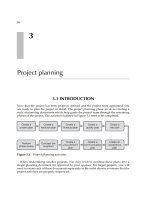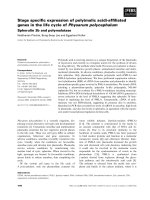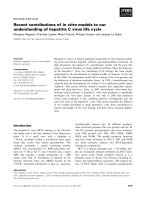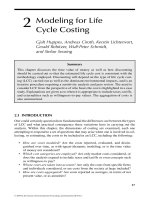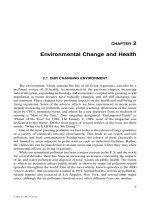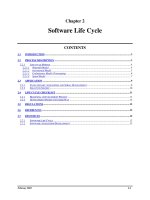ASSIGNMENT 2 Softwave Development Life Cycle
Bạn đang xem bản rút gọn của tài liệu. Xem và tải ngay bản đầy đủ của tài liệu tại đây (5.17 MB, 65 trang )
ASSIGNMENT 2
Qualification
BTEC Level 5 HND Diploma in Computing
Unit number and title
Unit 9: Software Development Life Cycle
Submission date
31/07/2023
Date Received 1st submission
Re-submission Date
Date Received 2nd submission
Student Name
Class
Student ID
0862620450
Assessor name
Student declaration
I certify that the assignment submission is entirely my work and I fully understand the consequences of plagiarism. I understand that
making a false declaration is a form of malpractice.
Student’s signature
Conghoang.tran
Grading grid
P5
P6
P7
M3
M4
M5
M6
D3
Summative Feedback:
Grade:
Internal Verifier’s Comments:
Signature & Date:
Resubmission Feedback:
Assessor Signature:
Date:
Table of Contents
A. Introduction.......................................................................................................................................... 5
B.
Content................................................................................................................................................. 6
P5: Undertake a software investigation to meet a business need..........................................................6
I.
TuneSource Project Overview.......................................................................................................6
1)
About the Tune Source project and its goals............................................................................6
2)
Importance of requirements definition in software development..........................................6
II.
The concept of Requirement.........................................................................................................7
1)
Definition of the requirement...................................................................................................7
2)
Different types of requirements................................................................................................7
3)
Criteria for assessing the importance of requirements............................................................7
III.
Classification of requests...........................................................................................................8
1)
Functional requirements........................................................................................................... 8
2)
Non-functional requirements....................................................................................................8
3)
Difference between functional requirements and non-functional requirements....................9
IV.
Applied in Tune Source project................................................................................................. 9
1)
List the functional and non-functional requirements for the Tune Source project.................9
2)
Detailed description of each requirement and their importance to the project...................10
3)
Prioritize requirements and plan implementation.................................................................10
V. Requirements gathering techniques in Tune Source..................................................................11
1)
List the functional and non-functional requirements for the Tune Source project...............11
2)
Detailed description of each requirement and their importance to the project...................11
3)
Prioritize requirements and plan implementation.................................................................12
4)
Business Process Improvement Techniques...........................................................................13
VI.
Conclude.................................................................................................................................. 15
P6: Use appropriate software analysis tools/techniques to carry out a software investigation and
create supporting documentation.........................................................................................................16
I.
Use Case Diagrams...................................................................................................................... 16
1)
Introduction to Use Case Diagrams.........................................................................................16
Tran cong hoang
1
2)
Components of a Use Case Diagram....................................................................................... 16
3)
Creating a Use Case Diagram...................................................................................................17
4)
Best Practices for Use Case Diagrams......................................................................................18
5)
Applying Use Case Diagrams to a Project of TuneSource.......................................................18
II.
Data flow Diagram.......................................................................................................................20
1)
Introduction to Data Flow Diagrams.......................................................................................20
2)
Components of a Data Flow Diagram......................................................................................21
3)
Creating a Data Flow Diagram.................................................................................................23
4)
Best Practices for Data Flow Diagrams....................................................................................23
5)
Applying Data Flow Diagrams to a project of TuneSource.....................................................24
III.
Entity Relation Diagram...........................................................................................................26
1)
Introduction to Entity-Relationship Diagrams........................................................................26
2)
Components of an Entity-Relationship Diagram.....................................................................27
3)
Creating an Entity-Relationship Diagram................................................................................28
4)
Best Practices for Entity-Relationship Diagrams.....................................................................29
5)
Applying Entity-Relationship Diagrams to a Project...............................................................29
P7: Explain how user and software requirements have been addressed.............................................32
I.
Wireframe of the project............................................................................................................ 32
1.
Wireframe for login and registration......................................................................................32
2.
Wireframe for admin page...................................................................................................... 33
II.
Database design.......................................................................................................................... 36
1)
Data tables............................................................................................................................... 36
2)
Relationships between tables................................................................................................. 38
3)
Architectural design.................................................................................................................38
III.
User manual for the project.................................................................................................... 39
1)
Instructions for registration and login.....................................................................................39
2)
Instructions for adding, editing, and deleting artists..............................................................40
3)
Instructions for adding, editing, and deleting genres.............................................................46
4)
Instructions for adding, editing and deleting albums.............................................................50
Tran cong hoang
2
C.
5)
Instructions for adding, editing and deleting songs................................................................55
6)
Logout...................................................................................................................................... 60
Conclusion.......................................................................................................................................... 62
D. References.......................................................................................................................................... 63
List of Figure
Figure 1: Use case Diagram...................................................................................................................... 16
Figure 2: Use case diagram of online shopping system............................................................................17
Figure 3: Use case diagram of user.......................................................................................................... 19
Figure 4: Use case diagram of admin....................................................................................................... 20
Figure 5: Data flow diagram.....................................................................................................................21
Figure 6: Components of a data flow diagram.........................................................................................22
Figure 7: Data flow diagram of student management.............................................................................23
Figure 8: Context Diagram........................................................................................................................25
Figure 9: Level 0 Admin............................................................................................................................ 26
Figure 10: Entity Relation Diagram...........................................................................................................27
Figure 11: ERD.......................................................................................................................................... 30
Figure 12: Wireframe login...................................................................................................................... 32
Figure 13: Wireframe register..................................................................................................................33
Figure 14: Wireframe dasdboard............................................................................................................. 33
Figure 15: Wireframe album.................................................................................................................... 34
Figure 16: Wireframe song.......................................................................................................................34
Figure 17: Wireframe genre.....................................................................................................................35
Figure 18: Wireframe artist...................................................................................................................... 35
Figure 19: Web register............................................................................................................................39
Figure 20: Web login................................................................................................................................ 40
Figure 21: Web dasdhoard.......................................................................................................................40
Figure 22: Web artist................................................................................................................................41
Figure 23: Button Add artist..................................................................................................................... 41
Figure 24: Add artist.................................................................................................................................42
Figure 25: Action add new arrtist.............................................................................................................42
Figure 26: After when add artist success..................................................................................................43
Figure 27: Edit artist................................................................................................................................. 43
Figure 28: Adit Artist................................................................................................................................ 44
Figure 29: Input information need edit....................................................................................................44
Figure 30: After edit artist........................................................................................................................ 45
Figure 31: Delete Artist............................................................................................................................ 45
Figure 32: Delete Success.........................................................................................................................46
Tran cong hoang
3
Figure 33: Add genre................................................................................................................................ 46
Figure 34: Click add genre........................................................................................................................ 47
Figure 35: Add genre................................................................................................................................ 47
Figure 36: Edit genre................................................................................................................................ 48
Figure 37: Edit genre................................................................................................................................ 48
Figure 38: Edit genre................................................................................................................................ 49
Figure 39: Edit genre success................................................................................................................... 49
Figure 40: Delete genre............................................................................................................................50
Figure 41: Delete genre............................................................................................................................50
Figure 42: Web album.............................................................................................................................. 51
Figure 43: Add Album...............................................................................................................................51
Figure 44: Add album............................................................................................................................... 52
Figure 45: After add album.......................................................................................................................52
Figure 46: Edit album............................................................................................................................... 53
Figure 47: Edit success............................................................................................................................. 54
Figure 48: Delete album........................................................................................................................... 54
Figure 49: Add song..................................................................................................................................55
Figure 50: Add song..................................................................................................................................55
Figure 51: Add song..................................................................................................................................56
Figure 52: Input data................................................................................................................................56
Figure 53: Save song.................................................................................................................................57
Figure 54: Add song success.....................................................................................................................57
Figure 55: Button edit song......................................................................................................................58
Figure 56: Edit web.................................................................................................................................. 58
Figure 57: Edit success............................................................................................................................. 59
Figure 58: Delete song............................................................................................................................. 59
Figure 59: Warning delete........................................................................................................................60
Figure 60: After delete............................................................................................................................. 60
Figure 61: Logout..................................................................................................................................... 61
Figure 62: Logout success.........................................................................................................................61
List of Table
Table 1: Table Admin.................................................................................................................................. 36
Table 2" Table artist....................................................................................................................................36
Table 3: Table genre................................................................................................................................... 37
Table 4: Table album.................................................................................................................................. 37
Table 5: Table song..................................................................................................................................... 38
Tran cong hoang
4
A.
Introduction
In the first report, I discussed software lifecycle models for Tune Source, a southern California-based
company that specializes in hard-to-find classical music recordings. I evaluated four different software
lifecycle models: Waterfall, V-Model, Spiral, and Rapid Development and determined that the Waterfall
model could be the best choice for Tuning Sources. We also discuss risk management and the
importance of conducting a feasibility study.
In this second report, I will continue to analyze Tune Source's project to make it possible to sell digital
music downloads to customers through their in-store kiosks and over the Internet by use their website.
The report is divided into several sections, each addressing a specific aspect of the project.
Section P5 discusses the software investigation done to meet the business needs of Tune Source. This
involves identifying business needs and gathering information from stakeholders such as customers,
employees, and management using techniques such as interviews, surveys, and focus groups. Existing
documents and data are also analyzed to identify business needs and requirements.
Section P6 describes the use of appropriate software analysis tools and techniques to perform software
investigations and generate supporting documentation. This includes documenting requirements using
tools like user stories, use cases, and functional requirements, and creating diagrams like Use Case
diagrams, Relationship diagrams entity system (ERD) and Data Flow diagram (DFD) to help visualize and
understand the system to be implemented.
Section P7 explains how to address user and software requirements. This involves using methods such as
software behavior specification methods to model the behavior of the system and show how it meets
requirements. The reliability and efficiency of the software is also evaluated by conducting tests such as
unit testing, integration testing, and system testing.
It is my hope that this report will provide a comprehensive and detailed analysis of the Tune Source
project, including specific sections that address various aspects of the project.
Tran cong hoang
5
B.
Content
P5: Undertake a software investigation to meet a
business need.
I. TuneSource Project Overview.
1) About the Tune Source project and its goals.
a) About the Tune Source project
Tune Source is a company based in southern California, founded by three entrepreneurs with
connections to the music industry: John Margolis, Megan Taylor, and Phil Cooper. Initially, John and
Phil teamed up to open a number of stores in southern California specializing in classic and hard-tofind jazz, rock, country and folk recordings. Megan was later invited to join the company because of
her connections and knowledge of classical music. Tune Source is quickly becoming the place to go
for rare audio recordings. Last year's annual sales was $40 million with an annual growth of about
3%-5% per year. Tune Source now has a website that allows customers to search and buy CDs.
b) The goal of P5
The goal of P5 was to conduct a software investigation to meet the business needs of Tune Source.
Specifically, this project was initiated to increase sales by creating the ability to sell downloaded
digital music to customers through their in-store kiosks and over the Internet using their website. To
this end, P5 will focus on defining the requirements for the software and using the appropriate
software analysis tools/techniques to perform the software investigation and generate supporting
documentation.
2) Importance of requirements definition in software development.
Determining requirements is an important step in the software development process. Requirements
are the conditions or capabilities that the software needs to meet in order to meet user needs and
achieve business goals. Defining requirements helps ensure that the software will meet user needs
and deliver value to the business.
Failure to define requirements correctly can lead to software development that does not meet user
needs, resulting in wasted time and costs. In addition, failure to define the exact requirements can
also lead to software errors or omissions, making it difficult to use and maintain.
Therefore, defining requirements is an important step to ensure that the software will meet the
needs of users and bring value to the business. This saves time and money in the software
development process, and increases the likelihood of project success.
Tran cong hoang
6
II.The concept of Requirement.
1) Definition of the requirement.
Requirements are the conditions or capabilities that a system, product or service needs to meet to
meet user needs and achieve business goals. In software development, requirements play an
important role in shaping the functionality and features of the software, ensuring that it will meet
user needs and deliver value to the business.
There are two main types of requirements, functional requirements and non-functional
requirements. Functional requirements describe what the software should do, including specific
functions and features. Non-functional requirements describe other factors that affect the operation
of the software, including performance, scalability, security, etc.
Determining requirements is an important step in the software development process, helping to
ensure that the software will meet the needs of users and bring value to the business.
2) Different types of requirements.
In software development, there are two main types of requirements: functional requirements and
non-functional requirements.
Functional requirements describe what the software should do, including specific functions and
features. For example, in the Tune Source project, some functional requirements might include
allowing users to search music in a digital music archive, listen to music, purchase individual
downloads for a fixed fee per download. download, set up a customer subscription account that
allows unlimited downloads for a monthly fee, and purchase a music download gift card.
Non-functional requirements describe other factors that affect the operation of the software,
including performance, scalability, security, etc. For example, in the Tune Source project, some nonfunctional requirements might include ensuring that the system can handle high traffic during peak
periods, ensuring the security of personal information. customers and ensure the stability and
usability of the system.
Both of these types of requirements are important in shaping the functionality and features of the
software and ensuring that it will meet the needs of the users and deliver value to the business.
3) Criteria for assessing the importance of requirements.
To assess the importance of requirements, there are several criteria that can be used, including:
Revenue Impact: Requests can affect a business's revenue, for example new features that
can attract more customers or increase sales.
Tran cong hoang
7
Deployment difficulty: Requirements can have varying degrees of difficulty in
implementation, for example some requirements may take time and resources to develop.
Impact on customer experience: Requirements can affect the customer's experience when
using a product or service, for example new features can make the product easy to use more
usable or improve performance.
Conformity with business strategy: Requirements may be in line with the business strategy of
the enterprise, for example, some requirements can help the enterprise expand the market
or strengthen the competition.
Using these criteria to assess the importance of requirements can help you prioritize requirements
and plan for implementation accordingly.
III.
Classification of requests.
1) Functional requirements.
a) Define.
Functional requirements are requirements that describe what the software needs to do, including
specific functions and features. These requirements define the behavior of the system as it interacts
with users or other systems.
b) For example.
In an online sales application, some functional requirements might include allowing users to search
for products, view product details, add products to cart, pay for orders, and place orders. Order
status tracking. These requirements describe the specific functions the application needs to meet
the user's needs.
In the Tune Source project, some non-functional requirements may include ensuring that the system
can handle high traffic during peak periods, ensuring the security of customers' personal
information. and ensure the stability and usability of the system.
2) Non-functional requirements.
a) Define.
Non-functional requirements are those that describe the properties or characteristics of the system,
not the specific functions it needs to perform. These requirements relate to factors such as
performance, scalability, security, usability, and system stability.
b) For example.
In an online sales application, some non-functional requirements may include ensuring that the
system can handle high traffic during peak periods, ensuring the security of personal information.
customers and ensure the stability and usability of the system. These requirements do not describe
Tran cong hoang
8
the specific functions the application should have, but do affect the operation and user experience
of using the application.
In the Tune Source project, some non-functional requirements may include ensuring that the system
can handle high traffic during peak periods, ensuring the security of customers' personal
information. and ensure the stability and usability of the system.
3) Difference between functional requirements and non-functional
requirements.
Functional requirements and non-functional requirements are the two main types of requirements
in software development. Functional requirements describe what the software should do, including
specific functions and features. These requirements define the behavior of the system as it interacts
with users or other systems. For example, in an e-commerce application, some functional
requirements might include allowing users to search for products, view product details, add
products to cart, pay for orders. and track order status.
Whereas, non-functional requirements describe the properties or characteristics of the system, not
the specific functions it needs to perform. These requirements relate to factors such as
performance, scalability, security, usability, and system stability. For example, in an online sales
application, some non-functional requirements might include ensuring that the system can handle
high traffic during peak periods, ensuring information security. customers' personal information and
ensure the stability and usability of the system.
The key difference between functional requirements and non-functional requirements is that
functional requirements focus on specific functions and features of the software, while nonfunctional requirements deal with other factors that affect the operation of the software. soft. Both
of these types of requirements are important in shaping the functionality and features of the
software and ensuring that it will meet the needs of the users and deliver value to the business.
IV.
Applied in Tune Source project.
1) List the functional and non-functional requirements for the Tune Source
project.
a) TuneSource project functional requirements.
Search music in digital music archive
Listen to music
Purchase individual downloads for a flat fee per download
Set up a customer subscription account that allows unlimited downloads for a monthly fee
Buy music download gift cards
Tran cong hoang
9
b) TuneSource project non-functional requirements.
Performance: The system can handle high traffic during peak periods
Security: Ensuring the safety of customers' personal information
Usability: Ensure system stability and usability.
2) Detailed description of each requirement and their importance to the
project.
Search music in digital music archive: Allows users to search for songs by song title, artist
name, genre. This feature is important to make it easy for users to find the music they are
looking for.
Listen to music: Allows users to listen to a short sample of the song before deciding to buy.
This feature helps users have more information to make purchasing decisions.
Buy individual downloads for a flat fee per download: Allows users to purchase individual
songs for a flat fee. This feature gives users more choices when making purchases and helps
businesses get revenue from retail.
Set up a customer subscription account that allows unlimited downloads for a monthly fee:
Allows users to sign up for an account for unlimited downloads for a monthly fee. This feature
helps businesses get recurring revenue from customers and helps customers save costs when
shopping.
Buy music download gift cards: Allows users to purchase gift cards to give to others, allowing
recipients to use the card to purchase music on the website. This feature helps businesses
attract new customers and help customers have more choices of gifts for their loved ones.
Performance: The system can handle high traffic during peak periods. This requirement is
very important to ensure that the system works stably and is not overloaded when there are
many people accessing it at the same time.
Security: Ensuring the safety of customers' personal information. This requirement is
important to protect the privacy of your customers and to uphold their trust in the business.
Usability: Ensure the stability and usability of the system. This requirement is very important
to make it easy for users to use the system and have a good shopping experience.
3) Prioritize requirements and plan implementation.
To prioritize requirements and plan for deployment, you can take the following steps:
Determine the priority of requirements: Evaluate the importance of each requirement based
on criteria such as revenue impact, difficulty in implementation, impact level customer
experience and alignment with business strategy. Based on this assessment, determine a
priority for each requirement.
Tran cong hoang
10
Deployment planning: Based on the priority of the requirements, plan the implementation to
suit the available resources and time. Define an estimated time to complete each
requirement and create a detailed implementation schedule.
Follow the plan: Implement the requirements according to the planned schedule and monitor
the progress to ensure that the project is completed on time. If there are changes in the
implementation process, update the plan and notify stakeholders.
Prioritizing requirements and planning implementation carefully will help you make good use of the
resources and time available to complete the project efficiently.
V. Requirements gathering techniques in Tune Source.
1) List the functional and non-functional requirements for the Tune Source
project.
There are various techniques for requirements gathering in software development, including
interviews, surveys, focus groups, and document and data analysis.
Interviewing: Interviewing is a requirement gathering technique through direct
communication with stakeholders, such as users, customers or sales staff. Interviews help
gather detailed information about the needs and wants of stakeholders and help define
requirements for the software.
Survey: Survey is a inquiry gathering technique through sending questions to a large group of
people to gather information about their needs and desires. Surveys help gather information
from a representative group and help identify common requirements for the software.
Focus group: Focus group is a requirements gathering technique through holding group
discussions with stakeholders to gather information about their needs and wants. Focus
groups help gather insights from a variety of sources and help define requirements for the
software.
Document and data analysis: Document and data analysis is a requirements gathering
technique through the analysis of available documents and data to determine requirements
for software. This technique helps to define requirements based on already available
information and saves time and cost in requirements-gathering process.
All of these techniques have their own pros and cons and can be used flexibly according to the needs
of the project.
2) Detailed description of each requirement and their importance to the
project.
Requirements gathering techniques that can be applied to a Tune Source project are as follows:
Tran cong hoang
11
Interviews: Software developers may interview stakeholders, such as users, customers, or
salespeople, to gather information about their needs and desires for the software. The
questions in the interview can be prepared in advance and focus on topics related to the
project.
Survey: Software developers can design a survey and send it to a large group of users to
gather information about their needs and desires for the software. Survey questions can be
designed to gather specific information about software features and functions.
Focus groups: Software developers can hold group discussions with stakeholders to gather
information about their needs and desires for the software. During these discussions,
stakeholders can exchange ideas and make suggestions about software features and
functions.
Document and data analysis: Software developers can analyze existing documents and data,
such as business reports or customer data, to determine requirements for the software. This
analysis helps to identify requirements based on the information already available and saves
time and cost in the requirements collection process.
3) Prioritize requirements and plan implementation.
Prioritizing requirements and planning for implementation is an important step in the software
development process. It involves determining the relative importance of the different requirements
and deciding the order in which to execute them.
To prioritize requirements, several factors can be considered, such as the importance of the
requirement to the success of the project, the cost and effort required to implement it, and the
dependency between different requirements. Various techniques can be used to prioritize
requirements, such as the MoSCoW method, where the requirements are classified as Must-Have,
Should-Have, May-Have or Won't.
Once the requirements have been prioritized, an implementation plan can be developed. This
involves deciding in which order the requirements will be fulfilled, assigning resources and
responsibilities, and establishing timelines for completion. The implementation plan should be
regularly reviewed and updated as necessary to ensure that the project stays on track.
In summary, prioritizing requirements and planning their implementation is an important step to
ensure that the most important requirements are addressed first and that the project is completed
on time and within scope. micro-budget. It involves careful consideration of various factors and the
use of appropriate techniques to determine the relative importance of different requirements. A
well-developed execution plan can help ensure that the project is completed successfully.
Here are some additional details on each step:
Tran cong hoang
12
Prioritizing Requirements: This step involves evaluating each requirement to determine its
relative importance to the success of the project. Factors that can be considered include the
value the requirement brings to the project, its impact on other requirements, and its
feasibility in terms of cost and effort. Techniques such as the MoSCoW approach can be used
to classify requirements into different categories based on their importance.
Implementation planning: Once the requirements have been prioritized, an implementation
plan can be developed. This involves deciding in which order the requirements will be
fulfilled, assigning resources and responsibilities, and establishing timelines for completion.
The deployment plan should account for dependencies between different requirements and
should be flexible enough to accommodate changes as needed.
Review and update: The implementation plan should be regularly reviewed and updated as
necessary to ensure that it remains in line with the project's goals and objectives. This may
involve changing the order in which requirements are fulfilled or adjusting timelines to
accommodate new developments.
Overall, prioritizing requirements and planning their implementation is an important step in
ensuring that a software development project is completed successfully. By carefully considering
various factors and using the right techniques, it is possible to develop a well-structured plan that
helps ensure that the most important requirements are addressed first and the project is completed
on time and within budget.
4) Business Process Improvement Techniques.
a) Business process automation (BPA)
Definition: Business process automation (BPA) is the use of technology to automate business
processes to improve efficiency and reduce costs. BPA helps to reduce human intervention in
business processes and helps save time and costs.
Benefits: The benefits of BPA include improved efficiency, reduced costs, increased accuracy, and
reduced errors. BPA also improves tracking and control of business processes and helps businesses
make data-driven decisions.
Application to TuneSource: In the Tune Source project, BPA can be applied to automate business
processes such as music inventory management, order processing, and customer management.
Here are some examples of applying BPA to the Tune Source project:
- Automatic music store management: The system can automatically update the song store
when new tracks are added or deleted and alert the staff when the number of songs in the
archive reaches a certain threshold.
Tran cong hoang
13
- Automated order processing: The system can automatically process orders from customers,
including checking the validity of payment information, confirming orders and sending shipping
information to customers. .
- Automated customer management: The system can automatically manage customer
information, including updating contact information, tracking purchase history and sending
promotional information to customers.
b) Business process improvement (BPI)
Business Process Improvement (BPI) is a method used to improve the efficiency and performance of
business processes. BPI involves analyzing current processes, identifying problems and opportunities
for improvement, and redesigning processes to achieve better results.
Some of the benefits of applying BPI to a TuneSource project may include:
Increase efficiency: By optimizing business processes, reduce the time and costs associated
with performing daily tasks.
Reduce costs: By eliminating or automating manual steps in business processes, reduce labor
costs and increase efficiency.
Improve customer satisfaction: By improving product and service quality, increase customer
satisfaction and attract more new customers.
Here are some examples of applying BPI to a TuneSource project:
Search Engine Optimization: To help customers easily find the song they are looking for,
TuneSource can analyze search patterns and optimize the search function. This may include
refining the search algorithm, implementing filtering and sorting options, and providing
intelligent search suggestions.
User Experience Improvement: TuneSource may collect feedback from customers and use
that information to improve the user experience. This could include improving the user
interface, enhancing customer support, and providing more flexible payment options.
Optimize order processing: TuneSource can analyze current order processing and find ways
to improve it to reduce processing time and increase efficiency. This could include
automating some steps in the process, using new technology to track orders, and improving
delivery processes.
c) Business process reengineering (BPR)
Business Process Reengineering (BPR) is a method used to improve the performance of business
processes by completely redesigning them. BPR differs from other process improvement methods
such as Business Process Improvement (BPI) in that it emphasizes the complete reengineering of
existing processes rather than merely improving them.
Tran cong hoang
14
Some of the benefits of applying BPR to a TuneSource project may include:
Increased efficiency: By completely restructuring business processes, TuneSource is able to
reduce the time and costs associated with performing daily tasks.
Reduce costs: By eliminating or automating manual steps in business processes, TuneSource
can reduce labor costs and increase efficiency.
Improve customer satisfaction: By improving the quality of products and services,
TuneSource can increase customer satisfaction and attract more new customers.
Here are some examples of applying BPR to a TuneSource project:
Completely refactored search functionality: Instead of just optimizing the current search
functionality, TuneSource can completely refactor this functionality to achieve better results.
This may include implementing a new search system that uses new technology to analyze
data and provide more accurate search results.
Completely Reengineering User Experience: Instead of just improving the existing user
interface, TuneSource can completely refactor the user experience to achieve better results.
This may include implementing a new user interface, using new technology to enhance
customer support, and providing more flexible payment options.
Complete refactoring of order processing: Instead of just optimizing existing order
processing, TuneSource can completely refactor this process to achieve better results. This
may include implementing a new order processing system, using new technology to track
orders, and improving delivery processes.
VI.
Conclude.
In this P5, we learned about the Tune Source project and the importance of requirements definition
in software development. We've learned about requirements basics, different types of
requirements, and criteria for assessing requirements importance. We also learned about
requirements gathering techniques and how to apply them to a Tune Source project.
Accurate and complete requirements definition is an important step in ensuring that software is
developed that meets user needs and operates efficiently. By using sound requirements gathering
techniques and classifying requirements by importance, we can ensure that the most important
requirements are addressed first and the project is completed on time. and within the budget.
Hopefully the information in this P5 will help you better understand the definition of requirements
in software development and how to apply it to the Tune Source project.
Tran cong hoang
15
P6: Use appropriate software analysis
tools/techniques to carry out a software investigation
and create supporting documentation.
I. Use Case Diagrams.
1) Introduction to Use Case Diagrams.
Use Case Diagram is a type of behavioral diagram that provides a visual representation of the
interactions between users (actors) and a system. It shows the different use cases (functions or
features) provided by the system and the relationships between actors and use cases.
Figure 1: Use case Diagram
The purpose of a Use Case Diagram is to help identify and organize the requirements of a system. By
creating a Use Case Diagram, you can gain a better understanding of the different users of the
system, their goals, and how they interact with the system to achieve those goals. This can help
guide the development of the software, ensuring that it meets the needs of its users.
Use Case Diagrams can be used in software analysis and design to model the behavior of a system.
They are often used in the early stages of software development to help identify and prioritize
requirements, as well as to communicate these requirements to stakeholders. Use Case Diagrams
can also be used throughout the development process to validate that the software is meeting its
requirements and to guide testing and maintenance efforts.
2) Components of a Use Case Diagram.
The main components of a Use Case Diagram are actors, use cases, and relationships.
Tran cong hoang
16
- Actors: Actors represent the different types of users that interact with the system. They can be
human users, such as customers or administrators, or external systems that interact with the
system. In a Use Case Diagram, actors are typically represented by stick figures.
- Use cases: Use cases represent the different functions or features provided by the system. They
describe the actions that an actor can perform within the system to achieve a specific goal. In a Use
Case Diagram, use cases are typically represented by ovals.
- Relationships: Relationships represent the connections between actors and use cases, as well as
between different use cases. There are several types of relationships that can be used in a Use Case
Diagram, including include, extend, and generalization. An include relationship indicates that one
use case is included within another use case. An extend relationship indicates that one use case can
optionally extend the behavior of another use case. A generalization relationship indicates that one
use case is a more general version of another use case.
Here is an example of a Use Case Diagram for an online shopping system:
In this diagram, the Customer actor can perform several use cases, including Search Item, View Item,
Figure 2: Use case diagram of online shopping system
Add to Cart, and Checkout. The View Item use case includes the Add to Cart use case, indicating that
a customer can add an item to their cart while viewing it. The Checkout use case leads to the Pay use
case, indicating that a customer can pay for their items after checking out.
3) Creating a Use Case Diagram.
To create a Use Case Diagram, you can follow these steps:
Step 1 - Identify the actors: Start by identifying the different types of users that will interact with
the system. These can be human users, such as customers or administrators, or external systems
Tran cong hoang
17
that interact with the system. Consider the goals and needs of each actor to help guide the
development of the use cases.
Step 2 - Identify the use cases: Next, identify the different functions or features that the system
will provide to meet the needs of its actors. Each use case should represent a specific action that
an actor can perform within the system to achieve a specific goal.
Step 3 - Define relationships: Once you have identified the actors and use cases, define the
relationships between them. This can include relationships such as include, extend, and
generalization. Consider how each use case relates to other use cases and how they support the
goals of the actors.
Step 4 - Organize the diagram: Finally, organize the diagram in a clear and logical manner. Place
actors on the outside of the diagram, with use cases in the center. Use lines to connect actors to
their associated use cases and to show relationships between use cases. Use consistent notation
and labeling to make the diagram easy to understand.
4) Best Practices for Use Case Diagrams.
Here are some best practices for creating effective Use Case Diagrams:
Use consistent notation: Use a standard notation, such as the Unified Modeling Language
(UML), to create your Use Case Diagrams. This will make it easier for others to understand
your diagrams and help ensure that they are interpreted correctly.
Keep diagrams simple and easy to understand: Avoid cluttering your diagrams with too
many details or complex relationships. Instead, focus on the most important actors, use
cases, and relationships, and organize the diagram in a clear and logical manner.
Validate diagrams with stakeholders: Share your Use Case Diagrams with stakeholders, such
as users, developers, and managers, to ensure that they accurately represent the
requirements of the system. Use their feedback to refine and improve your diagrams.
Iterate and refine: Creating effective Use Case Diagrams is an iterative process. Don't be
afraid to make changes and refinements as you learn more about the system and its
requirements.
By following these best practices, you can create Use Case Diagrams that are clear, accurate, and
effective in communicating the requirements of a system.
5) Applying Use Case Diagrams to a Project of TuneSource.
a) Customers
Identify the actors: In the Tune Source project, one of the main actors is the Customer.
Tran cong hoang
18
